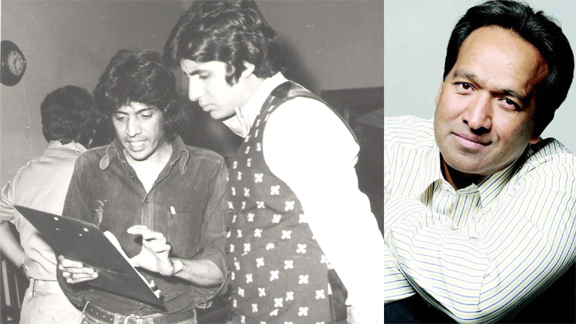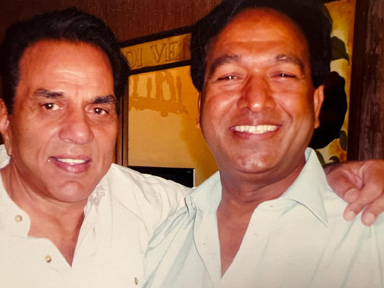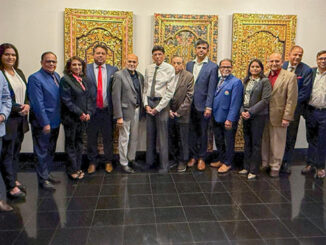
NEW YORK (TIP): When Chandra Barot passed away recently at the age of 86, obituaries rightfully celebrated him as the man who gave Indian cinema the cult classic Don (1978), starring Amitabh Bachchan, Zeenat Aman, and Pran, and based on a script by Salim-Javed. But among the many fascinating chapters of his life, one unfinished dream stood out—a forgotten film project that could have changed the course of Indian cinematic history: Big Daddy, India’s first planned 3D feature film, starring Dharmendra, Zeenat Aman, and Shammi Kapoor.
The year was 1983. The country was still new to the concept of three-dimensional cinema. Hollywood had just tasted success with Friday the 13th Part III (1982), a slasher film that became notable not just for its gore but for its groundbreaking use of the DePix 3D camera system. That technology, developed by American inventors Alvin and Mortimer Marks, captured the left and right eye perspectives on a single 35mm film frame. An innovation that made stereoscopic 3D cinema more accessible than ever before.
In a bold and visionary move, Indian American filmmaker Tirlok Malik—then a young dreamer deeply passionate about cinema—sought to bring this very system to Indian screens. Malik had already begun conversations with Mortimer Marks, who agreed to collaborate and adapt the Depix technology for Big Daddy. It was a story of scale and spectacle—a heist action-adventure film infused with music, dance, and the unique charisma of its three superstars. And with Chandra Barot, fresh off the success of Don, agreeing to direct, the project was poised to become a landmark.

But as with many visionary ventures, destiny had other plans. “The idea was way ahead of its time,” Tirlok Malik recalls. “We were trying to bring Hollywood technology to Bollywood storytelling, but the infrastructure, the costs, and the skepticism from producers held us back.”
Malik stayed with Barot at his Peddar Road residence for two months, as they worked towards getting the project rolling. “After Don, Barot was in talks with Dilip Kumar, who had shown interest in working with him. Barot was fixated on the idea of directing two of India’s finest actors, one after the other. But that project could never materialize, and Barot missed the opportunity to encash the success of Don,” explains Malik.
Despite the initial excitement, the project ran into insurmountable hurdles—technical, financial, and logistical. The Indian film industry in the early ’80s wasn’t ready to fully support the complexities of stereoscopic filmmaking. The sets were designed, camera tests were conducted, and preliminary footage was even discussed—but the film never went into full production. “I invited Chandra Barot to New York and introduced him to Mortimer Marks. Subsequently, Barot signed the three stars for the film—Dharmendra, Zeenat Aman, and Shammi Kapoor, who was to play the antagonistic titular character,” reveals Malik.
Yet for Malik, Big Daddy was not the end; it was a beginning. In the early 1990s, he shifted his focus to the U.S., where he would go on to pioneer a new wave of Indian American cinema. His 1991 feature Lonely in America, which he wrote, produced, and starred in, became a festival favorite and is today regarded as one of the earliest South Asian diaspora films to gain international recognition. The film was a heartfelt exploration of immigrant identity and the challenges of straddling two worlds—an experience Malik knew all too well.
Things came full circle when Malik collaborated with the creative minds behind India’s first released 3D film Chhota Chetan, on another film: Chhota Jadugar (also known internationally as Magic Magic 3D, directed by Jose Punnoose and produced by Navodaya Appachan and Allu Aravind. It combined Indian mythology, 3D innovation, and charming performances. Malik not only served as the U.S. producer on the film but also played a pivotal on-screen role, sharing screen space with the beloved playback singer and actor S. P. Balasubrahmanyam, who played his father. The film ran for five weeks at #1 at the Indian box office. It was also proved to be a technical triumph.
Years later, Chandra Barot and Malik met again at a film event. By then, Barot had retreated into semi-retirement, and Malik had become a torchbearer of Indian American storytelling. The meeting was emotional. Barot, ever gracious, congratulated Malik on Magic Magic 3D, even as he expressed a bittersweet regret: “Big Daddy could have been something truly historic. Alas, sometimes destiny has other plans.”
Over the years, Malik never let go of his love for family-oriented, visually rich storytelling. He went on to make films like Khushiyaan and On Golden Years, continuing to craft stories rooted in emotion and cross-cultural values. Today, Tirlok Malik remains a bridge between cultures, generations, and cinematic traditions. Based in New York, he is currently developing multiple international film projects, including a children’s feature inspired by folklore and spirituality.
As we remember Chandra Barot and the luminous, if unfulfilled, vision of Big Daddy, we are reminded of a simple truth: not all dreams are meant to be realized. “Chandra Barot, unfortunately, hasn’t gotten his due yet. He was a visionary filmmaker, a trailblazer whose legacy will continue to illuminate the way for the coming generation of filmmakers,” sums up Malik.





Be the first to comment